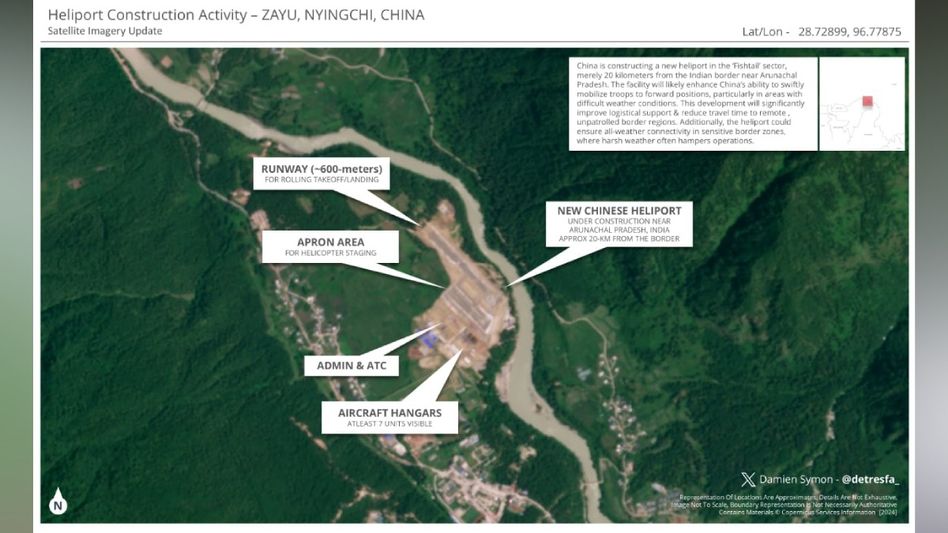New Chinese heliport near Arunachal Pradesh fuels strategic concerns along Indo-China border
A new Chinese heliport being built 20 kilometers east of the Line of Actual Control (LAC) near Arunachal Pradesh’s 'Fishtails' region could significantly boost China’s military capability in this underdeveloped and remote area.

A new Chinese heliport being built 20 kilometers east of the Line of Actual Control (LAC) near Arunachal Pradesh’s 'Fishtails' region could significantly boost China’s military capability in this underdeveloped and remote area. The heliport is part of China’s broader strategy of fortifying its military presence along the disputed frontier with India, raising fresh concerns in New Delhi, according to India Today reports.
As per reports by India Today, in a significant development that could alter the strategic landscape along the Indo-Chinese frontier, China is constructing a heliport just 20 kilometers east of the Line of Actual Control (LAC), near the sensitive 'Fishtails' region of Arunachal Pradesh. The facility, situated along the Gongrigabu Qu River in the Nyingchi Prefecture of the Tibet Autonomous Region, lies within undisputed Chinese territory. However, its location near a sensitive area of the border heightens concerns about China’s growing military capability in the region.
Open-source satellite imagery from EOS Data Analytics confirms that there was no construction at the heliport site as of December 1, 2023. However, by December 31, satellite images showed land clearing activity, marking the onset of the project. High-resolution imagery obtained from Maxar on September 16, 2024, indicates that construction has progressed significantly, with the heliport nearing completion.
Damien Symon, a geospatial intelligence expert who was among the first to identify the heliport’s existence, emphasized that the new facility would enhance the People’s Liberation Army’s (PLA) intelligence-gathering, surveillance, and reconnaissance capabilities. Symon noted that the heliport addresses logistical challenges in the rugged, densely forested region, which is difficult to access by conventional means. "The heliport enables rapid troop deployment to remote areas, strengthening patrol efficiency and expanding China's military footprint in strategically important locations," Symon added.
While the construction is within Chinese territory that India does not dispute, the strategic implications for India are concerning. The Fishtails region, named for the distinctive shape of the border in this area, is highly sensitive due to differing Indian and Chinese perceptions of the LAC. The region consists of two areas: Fishtail 1, located in the Dibang Valley, and Fishtail 2, partially situated in Arunachal Pradesh’s Anjaw district. Both areas are key flashpoints in the ongoing border tensions between the two nations, as per India Today reports.
Military experts and sources monitoring the construction describe the heliport as military infrastructure that enhances China's ability to conduct both defensive and offensive operations in the region. The heliport features a 600-meter runway that allows for rolling helicopter take-offs, a critical technique in high-altitude environments where helicopters have limited power. The area around the heliport, however, is situated at a relatively low altitude of 1,500 meters (approximately 5,000 feet), providing a significant operational advantage. This lower elevation allows helicopters and other aircraft to carry heavier payloads compared to higher-altitude regions of the Tibetan plateau.
Military sources caution that while the facility is primarily a military project, it may also have dual-use capabilities, allowing the movement of civilians into remote areas. Regardless of its civilian applications, the heliport is expected to dramatically improve China's ability to mobilize troops quickly in response to a potential conflict. "Their defensive and offensive operations will be enhanced, and their reaction capabilities increased. This allows for a speedy buildup of forces during any contingency," one source said.
Also read: Arunachal: APPSC resumes exams with transparency measures after two-year gap
Satellite imagery shows that the heliport includes at least three completed hangars, with four more under construction. A sizeable apron area is available for helicopters to park and operate, while other critical infrastructure such as an air traffic control facility and various support buildings are also in place. These features underscore China’s commitment to bolstering its military logistics in this region, which has historically been difficult to access.
The heliport’s construction comes at a time when China has been steadily building ‘Xiaokang’ or dual-use villages along its border with India. These villages, often positioned in disputed areas, serve both military and civilian functions. They represent a key tool in China’s territorial strategy, helping Beijing to gradually assert its claims through incremental changes on the ground. This strategy, often referred to as "salami slicing," involves small, steady advances in territory that alter the status quo without provoking major military conflict.
China has employed this strategy in various contested regions, most notably in Bhutan, where it has constructed entire townships and built extensive road networks in uninhabited border areas. Some of these areas are ancestral lands of Bhutan's royal family. The establishment of such settlements, combined with improved infrastructure, enables China to effectively control disputed territory without direct confrontation.
India, which has been locked in a tense border standoff with China since the violent skirmishes in Ladakh in 2020, has responded to China's infrastructure buildup by launching its own border development initiatives. One of the key responses is the ‘Vibrant Villages’ program, which aims to improve infrastructure in 3,000 villages located along India’s northeastern border, including in Arunachal Pradesh. The Indian government has allocated ₹4,800 crore for the first phase of the project, which aims to enhance living conditions and improve connectivity in remote border areas.
In addition to the Vibrant Villages program, India is working on completing a 2,400-kilometer trans-Arunachal highway. This project, along with several other road construction initiatives, is aimed at improving access to border areas and reducing travel times, particularly in eastern Arunachal Pradesh. The highway will also facilitate the movement of military personnel and equipment to forward posts along the LAC, strengthening India’s defensive capabilities.
India’s infrastructure development is a direct response to China’s aggressive border strategy, which includes not only the construction of dual-use villages but also the deployment of advanced military infrastructure, such as the new heliport near Arunachal Pradesh.
The construction of the heliport near the LAC underscores China’s increasing focus on enhancing its military presence along the Indo-Chinese frontier. While the heliport may have dual-use functions, its primary purpose is clearly to serve as a military facility, providing the PLA with greater mobility and improved intelligence-gathering capabilities. As India continues to monitor developments along the border, the heliport represents a new dimension of strategic competition between the two nations.
India’s countermeasures, including the Vibrant Villages program and improved road infrastructure, are crucial steps in responding to China’s assertive border strategy. However, the heliport’s completion will likely shift the balance of power in the region, intensifying the already complex dynamics along the Indo-Chinese border.
Copyright©2025 Living Media India Limited. For reprint rights: Syndications Today









